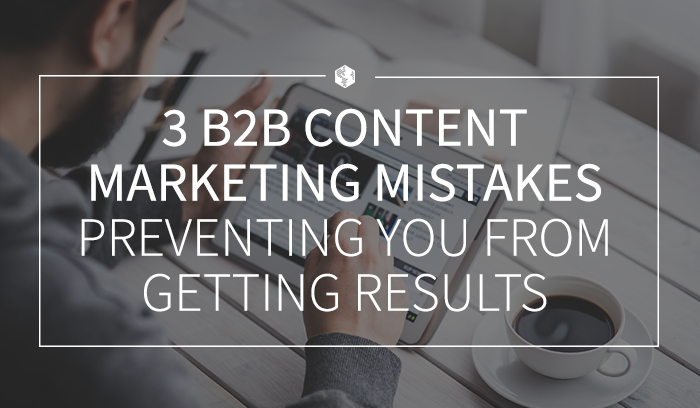Table Of Contents
A successful content marketing campaign isn’t always easy to create. Even if you know your target audience well, common mistakes can hold you back from attracting them to your website. In order to make strong, lasting connections with potential customers, you need to get to the root of the mistakes you’re making and eliminate them.
Many companies fall into the same problems when trying to create a content marketing strategy. From having an incomplete plan to not creating a proper budget, seemingly small issues can dramatically hinder your efforts. Luckily, there are simple solutions to each of these common mistakes.
To help you get your content marketing back on track, here are three common errors that may be preventing you from getting results—and what you can do to fix them!
Key Takeaways:
- Making mistakes with content marketing can hurt your entire business promotion plan.
- Not having a content marketing plan can cause you and your team to fall behind in sharing new information.
- Spending money to create high-quality content and promote it properly can attract better leads.
1. You’re Not Creating a Content Marketing Plan
Quality content takes time to create. In order to get the most benefit from your marketing, you’ll need to have content prepared and ready to go well before it actually needs to be shared. This means thinking ahead and developing a plan to create and share various forms of content.

A content marketing plan, like the above example template from CoSchedule, enables you to see exactly what you’re going to upload and how. If you’re not creating such a plan, you and your team may be unprepared and unfocused, and you may also have difficulty adapting to unexpected surprises or making decisions under pressure. On the other hand, by mapping out what channels your content will be posted on, when it will be sent out, and what it is going to include, you can get a birds-eye view of how it will move your leads through the buyer’s journey.
Your content marketing plan doesn’t need to be set in stone. Instead, it should be used as a guide to refer to at all decision points. For example, you’ll probably want to map out what content you would like to share, including the times and channels it will be posted on. However, if a more relevant or time-sensitive topic comes up, you have the freedom to adapt your plan and move content around. Remember that you always want to provide the best information possible for your target audience, even if that means making a few changes along the way.
2. You’re Not Spending Money
Many companies are under the impression that digital marketing can be done for free. While some aspects of social media marketing and online engagement can be conducted for little to no cost, that doesn’t mean you can market your entire business without a budget. If you aren’t investing in the process, you can’t be surprised when you get less than stellar results.
In order to attract high-quality leads, you need to create an appropriate budget for your content marketing. This can include everything from paying salaries to high-quality content creators, to allocating the necessary funds to properly promote your content online. Keep in mind that your target audience has many types of content to choose from. In order for yours to stand out, it needs to be well-crafted and highly visible. Don’t waste your time with low-quality content that will only be ignored by your target audience.
When trying to determine the right amount of money to spend on your content marketing, you’ll want to consider where your target audience is most active. You also want to take a look at how strong your competitors are and what they’re doing to market their own content. The amount of money you spend on content marketing should be comparable to your competitors, but should also be enough to ensure you’re attracting the right leads.

3. You’re Creating Low-Quality Content
Your content is the backbone of your marketing, and an important part of driving social media engagement, growing website traffic, and more. If you’re creating low-quality content that doesn’t connect with your target audience, you’re going to struggle to see results.
Unlike low-quality content, high-quality content considers the individual who is going to read, view, or listen to the piece—not the search engine crawler that may scan through it for keywords. By considering the needs of the actual person on the receiving end, you can answer their most pressing questions, clear up any concerns, or provide new and valuable information. This will improve trust in your brand and increase your chances of getting conversions.
To ensure your content is top-notch, do ample topic research to find out exactly what your target audience is looking for. Search social media and online forums, or even send out surveys and questionnaires to find what information they want but are not getting. Put in the time necessary to thoroughly understand your audience, and to determine the best form for providing what they need.
Bonus: You’re Not Properly Promoting Your Content
Some companies are under the impression that all they need to do is create content and post it to their website. Unfortunately, very few businesses or websites have enough of a following that target audience members will visit without at least some prompting. If you lack a strong promotion plan, your content won’t get noticed—meaning you’ll be wasting your time and money.

As part of your content marketing plan, you’ll want to include ideas about how you’re going to promote each piece of content. A clear promotion strategy ensures your content will be noticed, whether that’s through social media, as in the above example from CoSchedule, in a response to questions on a forum, or by having influencers share it with their own networks. Changing up the way you promote different kinds of content can also help you understand what channels your target audience members are using most often and what they’re connecting with best.
When deciding how to promote your content, consider what types your audience prefers. Know what social media channels they like, who they consider influencers, and what outlets they follow. You should also know whether they are active on specific forums, or if there are certain places they turn to for information. Don’t be afraid to use some trial and error to find the ideal promotion tactics for your content—you’ll be thanking yourself later.
Conclusion
Correcting your content marketing mistakes is important to the success of your company. If you’re allowing unsuccessful campaigns to run for too long, you could be missing out on high-quality leads and potential customers. However, being aware of common mistakes and implementing their solutions can help your company grow.
Let’s recap the four common B2B content marketing mistakes you need to address right away:
- You’re not creating and following a set content marketing plan.
- You’re not spending money to properly promote your content marketing strategy.
- You’re creating low-quality content that your audience doesn’t connect with.
- You’re not promoting your content in a way your target audience finds engaging.
How do you think solving these problems will change your content marketing? Let us know in the comments section below!
Image source: Pexels.






